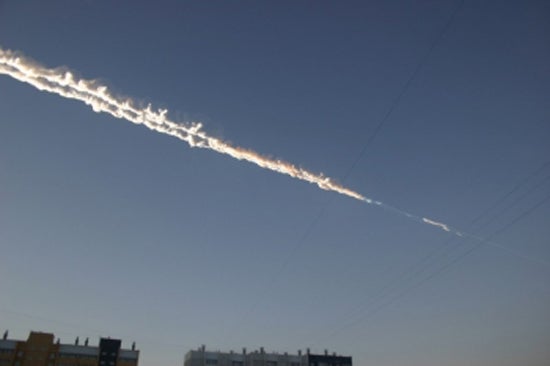According to the Ural Federal University, its scientists have found meteorites from the February 15 event, bringing them back to laboratories for analysis. According to the expedition leader Viktor Grokhovsky, a member of the Russian Academy of Sciences’ committee on meteorites, the meteorites belong to the class of regular chondrites.
As for damage on the ground, according to the Russian Emergency Ministry, the shock wave from the meteoroid’s disintegration broke windows in 2,962 buildings. Total damage covered 4,700 buildings and is estimated at more than 1 billion rubles ($33.2 million). In addition, 1,147 people applied for medical aid (including 259 children); 51 people (including 13 children) were hospitalized, only nine in moderately serious condition.
Per NASA, the estimated size of the object, prior to entering Earth’s atmosphere, has been revised to 55 feet (17 meters), and its estimated mass has increased to 10,000 tons. Also, the estimate for energy released during the event has increased to nearly 500 kilotons of energy released.
State officials said 19 people remained hospitalized as of February 18, the state-run news agency, RIA Novosti, reported.
According to Bill Cooke, lead for the Meteoroid Environments Office at NASA’s Marshall Space Flight Center in Huntsville, Alabama, the asteroid streaked through Earth’s atmosphere for approximately 30 seconds before it broke up 12 to 15 miles (19 to 24 km) above the surface. The resulting airburst released 300 to 500 kilotons of energy in a shock wave that quickly reached the ground.
For videos of the event, see “Meteor explodes over central Russia.”
According to Russia’s Interior Ministry, most of the damage from the shock wave was reported in six locations: Yemanzhelinsk, Etkul, Lithuania, Korkino, Yuzhnouralsk, and Chelyabinsk. The blast damaged buildings and shattered windows. The ministry told the state-run RIA Novosti news agency that about 1,000 people had been hurt, including more than 200 children. The deputy governor of the Chelyabinsk Region, Igor Murog, told a meeting with President Vladimir Putin and Emergency Minister Vladimir Puchkov on Friday afternoon local time that 514 people have applied for medical aid, including 82 children. Two of the injured are in “grave” state. According to Murog, the flow of those applying for medical aid has stopped.
Although this explosion was the largest one since the Tunguska event over Siberia in 1908, Earth regularly comes into contact with such debris. “Earth intercepts about 80 tons of meteoritic material per day,” Cooke said in a teleconference. Chodas added that a basketball-sized object hits Earth on average once per day and a car-sized one every month or two.
NASA is the worldwide leader in tracking large asteroids. The agency’s Near-Earth Object Program has found more than 95 percent of large near-Earth objects (more than 0.67 mile [1km] in diameter). The tiny asteroid that broke up over Russia could not have been detected through this program because of its size. The object also came out of the dayside of the planet, according to scientists.
This asteroid is unrelated to the other event February 15, when the much larger asteroid 2012 DA14 made a safe — and predicted — flyby of Earth.










